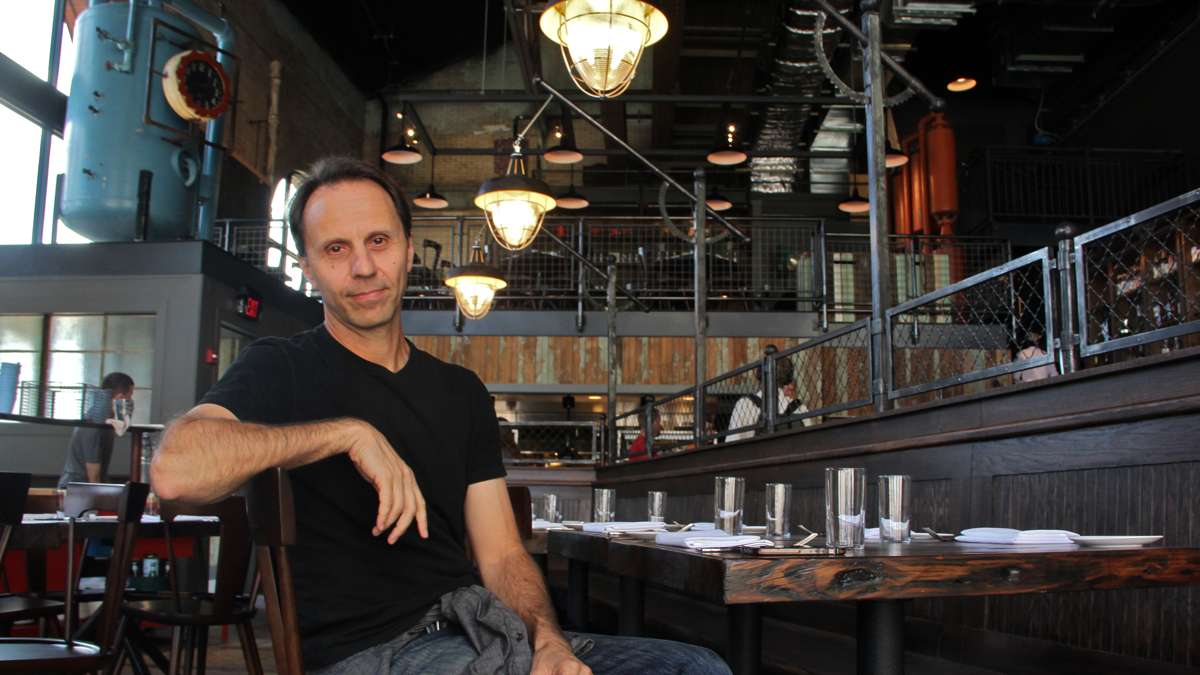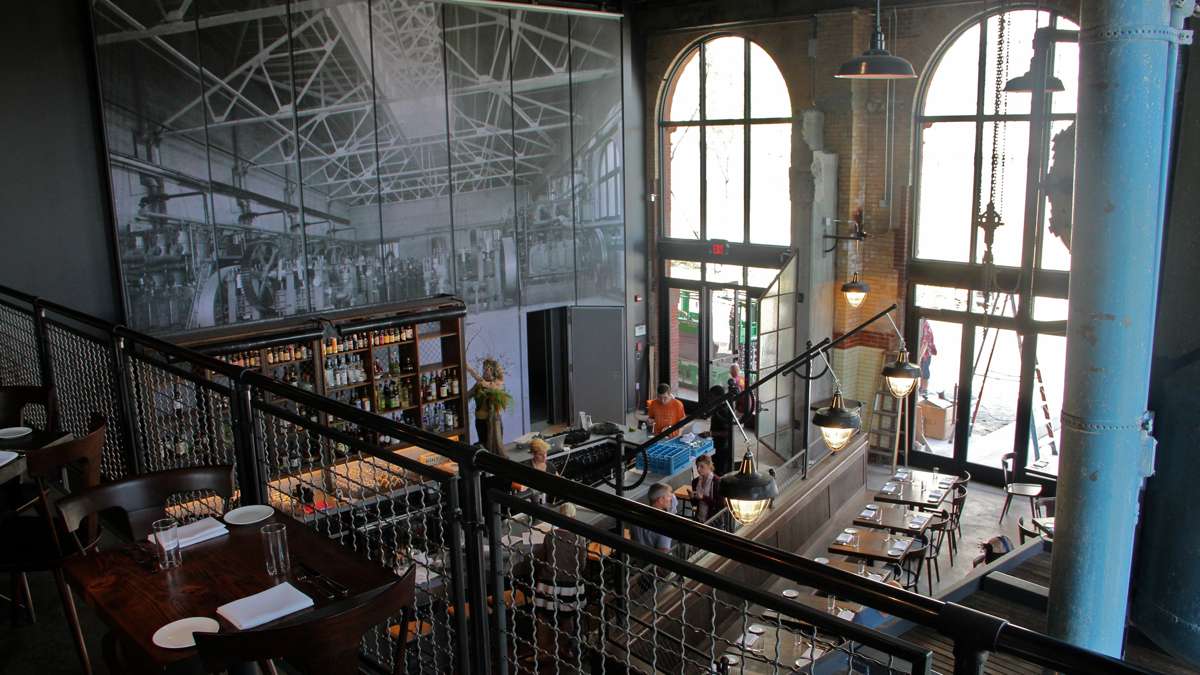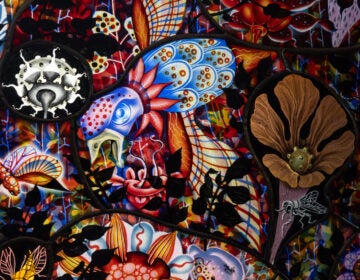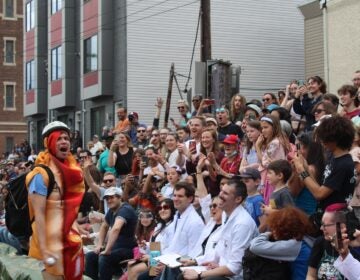FringeArts offers double feature: Dining and theater
ListenWhen the Fringe Festival begins after Labor Day in Philadelphia, it will launch a new combination theater and restaurant as the hub of year-round experimental performance. It may also usher in the future of the Delaware River waterfront.
The FringeArts stage could not open in time for last year’s festival — it debuted in late October. The new restaurant, La Peg, opening Monday, completes the concept.
Owner and executive chef Peter Woolsey also owns Bistrot La Minette, a French place near South Street. The menu at La Peg will also be French, with a twist.
“We’re being a bit more playful. It’s French-ish,” said Woolsey, who named the restaurant after his wife. “It will allow us to throw out the rules that we’ve been using for a while.”
He will feature offerings such as consommé based on Vietnamese pho soup with oxtail ravioli, and a choucroute garnie — an eastern France assemblage of meat, sauerkraut, and potato — here featuring blood sausage, something a traditionalist would never do.
That experimentation is on par with La Peg’s position as the front dining room of FringeArts, which features a 230-seat venue behind the bar and a cabaret stage in the corner. This is post-industrial brick behemoth, a former municipal pump house built in 1904, is the permanent home of the Fringe Festival, now in its 18th year of presenting experimental theater.
“I like the idea that FringeArts and La Peg are going to blur the lines of theater and food,” said Woolsey. “We’re creating something new here.”
One stop for dinner and a show
The marriage of fine dining and world-class theater is forbidden in cultural venues and, in some cases, city zoning code.
“In Europe, this is not a new idea. I stole this idea,” said FringeArts president and artistic director Nick Stuccio. “Part of this is cultural. Americans typically see a show, and they are trained to leave. The show is over, and they walk out. In other places, they don’t. They hang out in the art center. We’ll see what happens. It might take some reprogramming in people’s brains.”
For this experiment to work, people also have to be trained to do something else, perhaps more difficult: cross I-95 and come to the waterfront.
Stuccio chose this building in part because of its grand views of the Ben Franklin Bridge, and its position across the street from the Race Street Pier, a public park built on top of a former industrial pier. The outdoor terrace and beer garden will bring diners very close to the span and the milewide Delaware River.
“People like the water. I don’t know why,” said Stuccio. “It’s in our DNA. It’s lizard-brain stuff.”
The Race Street Pier park was built two years ago by the Delaware River Waterfront Corporation, whose Master Plan is a mixed-use vision of residential, commercial, and open green spaces. The city is still waiting for the tipping point when the waterfront will be reunited with city residents on a large scale.
“The opening of the restaurant is exactly what we want to have happen,” said Deputy Mayor of Economic Development Alan Greenberger. “The pier is a public amenity, but people are willing to make real investments down here to make this emerging scene of life on the waterfront. The Fringe Festival is a piece of that that comes from the cultural world.”
Greenberger says another development, a 150-unit mixed-use apartment building, will being going up soon nearby.
Fringe and neighborhood transformed
The new FringeArts building is the house that experimental theater built and, likewise, a gamble. When the Fringe Festival started 18 years ago, Old City was a downtrodden neighborhood lousy with vacancies.
“I had control of 128 properties at our disposal the first five years of the festival,” said Stuccio, remembering the days before the condo boom revitalized the area.
All those empty spaces nurtured artists to make work, try things, play, fail, succeed, or not. For the last eight years, Stuccio has wanted to gather the outer fringe into a central hub, where promising artists could be given state-of-the-art tools to make the best work they can. But for years his board held the reins tightly.
Several cultural venues in Philadelphia — and many more beyond — are in critical condition because their ambitious expansions could stir up the funds to pay the bills. The FringeArts board would not let this $8 million development move forward until it had raised 90 percent of the money.
Most of the organization’s resources went into finishing the building. As a result, other initiatives suffered. A program that had been called the Live Arts Brewery (The LAB) helped artists create new work from scratch. Stuccio says it has been phased out.
“We still believe deeply in the support of artists,” said Stuccio. “The resources we had for LAB, at first dedicated to deep research with no outcome, was beneficial. Now those resources are dedicated more toward the presentation side. We’re looking for completion. Those resources are pointed toward out presentation program.”
In addition to the 16-day festival, Stuccio now faces two stages hungry for content year-round. He says the organization will help artists with finishing resources, so he can get them on his stages.
WHYY is your source for fact-based, in-depth journalism and information. As a nonprofit organization, we rely on financial support from readers like you. Please give today.










